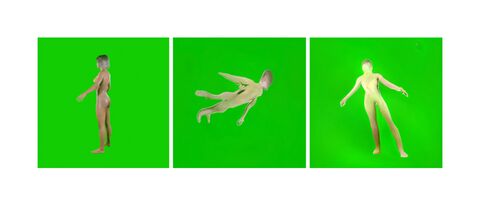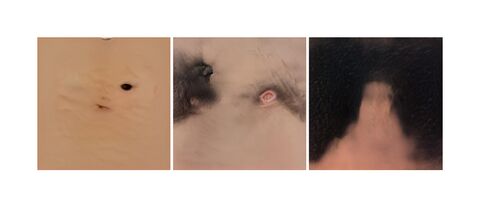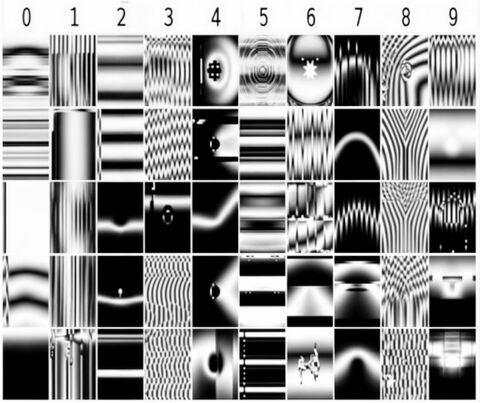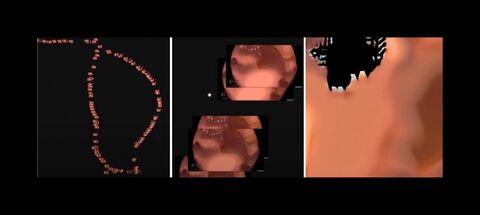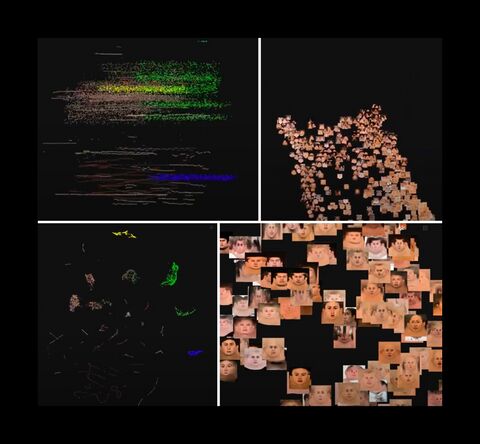Content Form:APRJA 13 Esther Rizo Casado: Difference between revisions
No edit summary |
|||
| Line 53: | Line 53: | ||
As a first experiment, to try how algorithms are trained in words like weird, xeno, alien bodies or genderless, we used the text-to-image models like Vector-Quantized Generative Adversarial Networks, VQGAN (Simonyan), which uses a vector quantisation technique to learn a discrete representation of data. VQGAN was used together with CLIP (Radford), a neural network model that is trained on a massive dataset of text and image pairs (see Fig. 4). The most prolific aspect was that in these 2022 models, the less they understood the text prompt, the more they tended to create unfamiliar corporealities. | As a first experiment, to try how algorithms are trained in words like weird, xeno, alien bodies or genderless, we used the text-to-image models like Vector-Quantized Generative Adversarial Networks, VQGAN (Simonyan), which uses a vector quantisation technique to learn a discrete representation of data. VQGAN was used together with CLIP (Radford), a neural network model that is trained on a massive dataset of text and image pairs (see Fig. 4). The most prolific aspect was that in these 2022 models, the less they understood the text prompt, the more they tended to create unfamiliar corporealities. | ||
[[File:ERC Figure 3.jpg|thumb| | [[File:ERC Figure 3.jpg|thumb|600px|Figure 3: Text-to-Image xeno-tuning protocols. Source: author.]] | ||
Experimenting with image-to-image models (see Fig. 4), we used StyleGAN2 (Karras) for inputting other images downloaded from internet, photographs we took of our bodies or generated by 3D software Blender (Roosendaal), together with the generative plugin Human Generator (Curtis) and modified with RunwayML (Germanidis), a distributed computing platform that allows users to run machine learning models at scale. We have modified the parameters of the algorithms thanks to the open-source cloud-based environment Jupyter Notebook (Kluyver), which allows anyone to write and execute arbitrary Python code in the browser. | Experimenting with image-to-image models (see Fig. 4), we used StyleGAN2 (Karras) for inputting other images downloaded from internet, photographs we took of our bodies or generated by 3D software Blender (Roosendaal), together with the generative plugin Human Generator (Curtis) and modified with RunwayML (Germanidis), a distributed computing platform that allows users to run machine learning models at scale. We have modified the parameters of the algorithms thanks to the open-source cloud-based environment Jupyter Notebook (Kluyver), which allows anyone to write and execute arbitrary Python code in the browser. | ||
[[File:ERC Figure 4.jpg|thumb| | [[File:ERC Figure 4.jpg|thumb|600px|Figure 4: Image-to-image xeno-tuning protocols. Source: author.]] | ||
Inside the image-to-image techniques, some xenoimages were generated by mixing flowers and porn image archives. This practice has shown us how the mix of these two worlds is not as simple as a human body with a flower head, but a rhizomatic (Deleuze) union of two systems within a more complex one. | Inside the image-to-image techniques, some xenoimages were generated by mixing flowers and porn image archives. This practice has shown us how the mix of these two worlds is not as simple as a human body with a flower head, but a rhizomatic (Deleuze) union of two systems within a more complex one. | ||
Revision as of 09:45, 7 September 2024
Esther Rizo Casado
Xeno-Tuning
Dissolving hegemonic identities in algorithmic multiplicity
Abstract
Xenoimage Dataset is an artistic practice that unleashes the hallucinatory capacities of image-generating AI to question the perpetuation of power dynamics inherent in normative gender dichotomies. Employing techniques called xeno-tuning, it adapts pre-trained models to produce weird representations of corporealities, criticising the homogenous tendencies and biases inherent in image datasets. The purpose is to define the visuality of the xeno as a transformative agent of current hegemonic identities.
The production of images has a crucial role in prospective thinking since we need to picture the future to face it. The Palaeolithic Chauvet cave was found with evidence on how hunters first painted the beasts they were going to kill and even stuck arrows on them, as if killing their image would put an end to anticipatory uncertainty. This study is based on the practice of creating a collection of images generated by artificial intelligence (AI) representing fictional and weird bodies. These bodies are not of the beasts we prepare to hunt; they are a visual imaginary where the multiplicity of represented identities enable "the right of everyone to speak as no one in particular" (Laboria Cuboniks). As the critical designers Dunne and Raby convey in their manifesto on speculative design: "We rarely develop scenarios that suggest how things should be because it becomes too didactic and even more moralistic. For us futures are not a destination or something to be strived for but a medium to aid imaginative thought – to speculate with." (3)
Historians of robotics conclude that, over the years, automata have been built for three fundamental functions: work, sex, and entertainment (Mayor 58). However, one of the activities we most like to entrust to AI models nowadays is that of predicting the future. This is especially true in fields such as education, work, security, politics and the environment (Zafra). Following Parikka's words: "Inferred and envisioned, futures form as part of the production of images" (11), this study uses synthetic images representing abstract bodies as speculative experiments on fictional identities. The missing visual exploration of the "xeno" which considers the networked image as "a cooperation between the quasi-autonomous operations of software and remediated socio-cultural forms. [...] a relational object with performative agency (and as such, it can also move or exist beyond the computational)" (Cox et al 40).
Looking at image creation statistics from 2023, text-to-image algorithms have generated as many images as photographers have taken between 1876 and 1975, a period of 150 years (Valyaeva). When we look at how images are generated by machine learning models, we observe that the past, in the form of datasets, is the only thing that feeds these systems. It happens even when the machine is connected to the internet in real time. Furthermore, the visual preterit with which we feed these models based on natural language interface is linked to a text description; a tag created by humans enabling machines to understand our world. Even if the humans behind tags, called annotators, represented all different cultures, genders and contexts, it would be inevitable that this image-tag combination would be biased. As Land mentions in his text Collapse: "it is not a question of building the future, but of dismantling the past" (49). Therefore, when we use generative models in the conscious act of image production as speculative thinking: will we be able to envision other futures non-concerned with an unresponsive past? Can we keep image generating tools away from human conservative injustices, such as identity biases or omissions?
Fascinated by how understanding anatomy is one of the most complicated concepts for image generative models, this study began by exalting the aesthetic value of the current mutations in generated content. Six-fingered hands emerging from machine learning bugs and computer vision's apophenia helps to visualise concepts of the xeno, the foreign, the liminal emerging from software cracks. The weird is a simultaneous and inseparable pleasure and pain, since the obscure or negative is what enhances enjoyment. As Mark Fisher understands it, positivity is an illusion: the world is a dark place, and we must be willing to confront that obscure weirdness. This uncomfortable feeling can be unsettling, but it can also be a way of confronting us with the unknown and discovering a way of dealing with life. Therefore, the collective art piece Xenoimage Dataset, on which this study is based, provokes visual hallucinations with algorithms like next-frame prediction or transforming visualisations of the body like a colonoscopy (see Fig. 1). In this example, images become speculative objects, showing other kinds of intelligences: a fluid computer-generated data object, non-delimited by realism or anthropocentric perspectives.
The resultant proto-dataset is not pretending to be functional by training other generative models on xenoimages. The archive is considered as feedback between conceptual thinking and subject matter. Its collection of images acts as a multi-author with the agency of generating software-based bodies representing soft-weird identities. The deforming and abstracting protocols used for exploring the unknown can be encompassed by the term 'xeno-tuning': a disruption from the fine-tuning technique. Instead of training each model from scratch, xeno-tuning utilises the capabilities of a pre-trained base model that has already acquired extensive learning and adapts it to a specific purpose: exploring unknown corporalities. Xenoimages represent bodies that are impossible to identify due to their fluid, asexual or non-anthropomorphic characteristics. Therefore, xeno-bodies which are sometimes non-identitarian and sometimes multi-identities. These liminal spaces help us think visually about what is a body, an identity, and every thing that constructs them.
The study of xenoimages, initiated by the artist Mar Osés, and continued during the participatory lab Sintient Media, in 2022, in the contemporary cultural centre Medialab Matadero, Madrid, created along the lines of Amy Ireland's Xenopoetics (155), leaving aside the importance of authorship by collective thinking processes. Since then, and following the premise that "virtual images are not objects that can be created all at once, but processes in progress" (Bottici 61), the search for xenoimages has become a long-term investigation developed by the collective XenoVisual Studies (XVS). In addition to testing different creative and experimental exercises, the collective organises exhibitions and knowledge transfer activities with citizens from Madrid and Buenos Aires, and cybernauts around the globe. In these gatherings different intelligences, especially those affected by identity biases, come together with the objective of generating consciousness about current oppressive algorithmic imaginaries.
The homophilic context
Authors have been pointing to a homogenisation of human identity through contexts like scientific eurocentric hegemony, bureaucratic categorisation, work automatisation and social alienation. Postmodern feminist Rosi Braidotti rejects unitary identities modelled on the humanist, normative, and Eurocentric context (52). Franco Berardi describes work automation not as something to do with software but as the replication of these entrenched intentionalities and established forms of human relations (113). Stuart Levine and Marshall McLuhan argue that technology forces us into the entanglement of thoughts, desires, and passions of our fellow human beings as an alienation process (646). Lastly, Remedios Zafra warns us that the times we live in favour categories that hinder a necessary detour from excess and acceleration (102).
The cybersphere that emerged in the 1990s was a text-based interaction where anonymity provided a safe space to experiment with components of human identity. The current democratisation of image-making and the dissemination of photographs and selfies through mobile phones and web 2.0 have become design tools for our digital selves. The real impact of these tools has been that companies are the decision-takers in identity matters. Images are detached from their representative or human functions (Farocki; Parikka and Gil-Fournier 11); even those created by humans, become data, therefore operational images, feeding algorithms. We have gone from being the creators and promoters of our self-image to leaving it in the hands of those who design algorithms. The main purpose of the companies that design algorithmic social communications is to feed our fear of not being socially accepted, based on a sense of belonging (Navarro). That is why society tends to favour homogenising imitation as a cultural generator and curator. The bulk of digital identity is nothing more than wanting to look like others (see Fig. 2).
The Xeno tendency
Xenofeminists believe in new rationalism, and by that they understand all kinds of intelligences (human and non-human) to be found in the xeno, the unknown, a force of speculating new worlds like anti-identitarian futures. Furthermore, this cyberfeminism contextualises the xeno in the world of technology, as new technological incorporations are often seen as entities that do not fit the organic or physical world, difficult to understand, and therefore weird.
The choice of the particle 'xeno' – by the theorists Laboria Cuboniks, and for this study – has to do with the ancient meanings of weird: 'fateful', from the Latin 'fatidicum', the root of which is 'fatum', meaning 'destiny'. Therefore, we can speculate that the sensation attached to predicting the future is of a weird nature: "what we need are people who can become stranger than the strange world we have produced" (Davis 13). The word 'xenomorph' is originally linked to science fiction novels that through imagination, linguistic description, illustration and finally audiovisuals investigate the possibilities of other identities that do not belong to the living organisms we have seen on earth. This study considers the xeno in terms of speculative fiction to imagine other possible identities, thus avoiding oppressions of some bodies over others. The difference between science fiction xenomorphic bodies and mathematical models generating images with the aesthetics of the xeno has to do, on the one hand, with the potential of these computational combinatorics and, on the other, with the hallucinatory tendency of generative models. What we call 'artificial hallucinations' is the way machine learning models acquire knowledge; it is not situated, synchronous learning like humans, and it is precisely this that makes it worthy of further exploration.
Xenofeminists have faced criticism for choosing the prefix 'xeno' (Goh), mostly attached to derogatory terms like xenophobia or the term alien which shows little sensitivity to the Marxian conflicting meaning of 'alienation' (dehumanisation of the human being, creating a superhuman, a God). Aware of this critique, the XVS collective emphasises the subversive attitude with which it confronts the algorithmic culture of the image, extending this approach to the language realm. They subject the terms xeno or alien to the same decolonial process applied to the production of images. Alien, therefore, refers to the transformative potential of weirdness and the radical inclusion of diversity to re-imagine a more equitable and inclusive society. After these semantic concerns, one of the xenofeminist collective, Lucca Frasser, describes the meaning of alienation as 'disrooting' (translated by Toni Navarro as 'desarraigo') which XVS identifies as a non-identitarian scenario that connects perfectly with its investigation. Therefore, xenophilic practices include displacing prevailing hegemonic norms, like the tendency for attaching xeno to phobia or alien to Marx. On the other hand, the incendiary usage of the term 'appropriation' in Annie Goh's article "Appropriating the Alien", could be argued to be in the same direction. Appropriationism generally occurs when a privileged group adopts aspects of the culture of a more vulnerable group, often without permission and in an exploitative manner.
Another value of xenofeminism has to do with its anti-naturalist approach which does not understand nature and technology as separate entities. Following Mark Fisher's theory about The Weird and the Eerie (58), in which the 'weird' tends to live away from anthropocentric and normative landscapes, and inhabits the world of liminality, with its continuous mutations. It cannot be described as pure human or non-human, female or male, inside or outside. A relevant example of this non-binarism in the weird is the uncanny valley: when anthropomorphic replicas, like robots, come too close to our appearance and behaviour, we cannot classify them as human or machine, and it causes a rejection response when we observe or interact with them. XVS takes this uncanny valley feeling as a strategy for exploring unexplored spaces.
The slow cancellation of hardware-based future
Accelerationists like Mark Fisher conjure that nowadays "culture has lost the ability to grasp and articulate the present. Or it could be that, in one very important sense, there is no present to grasp and articulate anymore" (54). Their stated reason is "a lack of imagination" in late capitalist society. Simon Reynolds, on the other hand, argues that what has been dying is a certain metallic-robotic aesthetic, and that futurism lives in a surprisingly organic way (Reynolds); not only organic in the sense that this term is usually given, but full of organs like (artificially intelligent) brains. We can confirm this aesthetic turn by comparing the Kraftwerkian futuristic style of the 1970s, metallic and wiring, hardware heavy and robot-centric, in contrast with the futurability that emerges from software-based examples like applying distorting voice techniques, auto-tune, to human voices (Reynolds 11-19), artificial filters to our faces, or the poetry in fictional theory: "She becomes the Body without Sex Organs: The body in a virtual state, ready to plug its desire into technocapital, becoming fused with technocapital as a molecular cyborg who is made flesh by the pharmaceutical-medical industry" (n1x).
Having placed the chosen aesthetic in this soft-organic context, I will explain the different techniques on which xenoimage production is based.
Artificial imagination and xeno-tuning
Image generation and algorithmic prediction can learn from past acts and speculate about the future, but if the algorithm does not identify a statistically matched visual option in its prediction, it will practise apophenia by finding meaning in random stimuli. Not only will it invent the next image, but it will also be able to see shapes in the noise, and can produce an infinite number of variations. Following the tactic that xenofeminism uses for gender abolitionism (Hester) – advocating for a plurality of gender identities that transcend binary and rigid categories – XVS uses multiplication of fictional identities as a fluid where hegemony goes unnoticed, getting lost in the immensity of the archive. Experiments with the representation of bodies in art need not follow laws. We can explore themes of identity and anti-identity through digital fluidity which allows us to test visual incognitas: at what point does a human body cease to look capitalised, binary, human?
The history of science fiction has turned us into spectators of attempts to imagine through the hybridisation and combination of humans with other corporealities. The mixture between two worlds has been a recurring resource when creating these imaginaries: the panther woman, the fly man, Kafka's Metamorphosis, the alien, cyborgs, and many more. In speculative image theory, these hybridisations have been superseded by more complex analogies that connect with the xenoimage nature, for instance: Jussi Parikka's insect media as an anti-species example that challenges our traditional views of the natural and the artificial; or Donna Haraway's critters as companion species that are not just pets, but rather co-evolutionary partners that shape our identities.
By the 2010s, the creation of music and images began to take on ever-stranger forms of beauty. If you look into the excessively auto-tuned voices in pop music or the hands generated by generative algorithms, you will find a strange aesthetic fluidity: "Identities will be corrupted. Believe in the mystery of digital DNA reconfiguration. Allow your bones to crush, let your brain grow out of your skull. It's time we accept that our physicality is just a mere fantasy." (DB) Xeno-tuning techniques specifically allow us to modify a deep learning model for generating images trained on a dataset of normative bodies and redesign them to generate other types of entities. To this end, we have found various forms of xeno-tuning which are described below.
As a first experiment, to try how algorithms are trained in words like weird, xeno, alien bodies or genderless, we used the text-to-image models like Vector-Quantized Generative Adversarial Networks, VQGAN (Simonyan), which uses a vector quantisation technique to learn a discrete representation of data. VQGAN was used together with CLIP (Radford), a neural network model that is trained on a massive dataset of text and image pairs (see Fig. 4). The most prolific aspect was that in these 2022 models, the less they understood the text prompt, the more they tended to create unfamiliar corporealities.
Experimenting with image-to-image models (see Fig. 4), we used StyleGAN2 (Karras) for inputting other images downloaded from internet, photographs we took of our bodies or generated by 3D software Blender (Roosendaal), together with the generative plugin Human Generator (Curtis) and modified with RunwayML (Germanidis), a distributed computing platform that allows users to run machine learning models at scale. We have modified the parameters of the algorithms thanks to the open-source cloud-based environment Jupyter Notebook (Kluyver), which allows anyone to write and execute arbitrary Python code in the browser.
Inside the image-to-image techniques, some xenoimages were generated by mixing flowers and porn image archives. This practice has shown us how the mix of these two worlds is not as simple as a human body with a flower head, but a rhizomatic (Deleuze) union of two systems within a more complex one.
Another xeno-tuning technique was generating dozens of normative bodies with the 3D software Blender and its plugin Human Generator. These bodies were then transformed with the RunWay ML model, forcing the algorithm to generate something uncategorizable.
Nudity, foreshortening, absence of the face, and more irregular pictures of human bodies confuse trained computational vision. The artist Claudix Vanesix, part of the collective practice Xenoimage Dataset, prompted images of their body with these kinds of conditions: nudity, absence of face and foreshortening framing. As a result, the algorithm speculated all kinds of creatures far from anthropomorphic tendencies.
Asking ourselves questions like 'are faces the ones that bear the burden of defining identity?', we also used the extant algorithm This Person Doesn't Exist (Wang) to generate human faces and xeno-tune them with Style-GAN 2.
Computational prevision
Until computer vision, the only way for machines to predict, for example, the weather was through numerical models and measurements. Since algorithms can see, they analyse the images they capture to learn from them. Once they learn, they create speculative images of what might happen in the future based on what has already happened. This gives rise to forms of machine creation such as next-frame prediction (Zhou), synthetic apophenia (Parikka), and nowcasting. Nowcasting techniques, widely used in foresight practices such as meteorology, demonstrate how the very act of capturing images of the real world and recording them leads to a calculable future: images give rise to other images. Next-frame prediction algorithms can learn from past acts and speculate on the future, but if the algorithm does not find a statistically matching visual option in its prediction, it will practise apophenia: sensing meaning in random stimuli (Steyerl). Not only will it invent the next frame, but it will also be able to see shapes in the noise (Nguyen).
Filmmaker and theorist Harun Farocki compares the extent to which humans and machines are both similar and dissimilar when it comes to the act of seeing and recognition (Jacarilla). He makes us think about the loss of the human ability to differentiate between real and fictional images (see Fig. 10). At the same time, he acknowledges the ability of machines to see using image recognition and processing software. Farocki's operational images do not represent a process but are part of one. They are often invisible to the human eye (see Fig. 9). Most of them are created by machines for machines (Paglen), and therefore, nowadays, for humans, "Not seeing anything intelligible is the new normal" (Steyerl).
We see how photography, in its evolution, affected by emerging technologies, has already moved away from the values that have been historically attributed to it. It is abandoning romantic notions of authorship, originality, truth and beauty. The man-machine combination becomes concrete, according to Farocki, in the eye-machine combination when he analyses the functioning of intelligent machines and what they see when they work based on image recognition and processing software. Deep Neural Networks (DNNs) seek to replicate how the brain processes information, but in some cases they even see what humans cannot. These have been called 'deceptive images' (Baudrillard). The paradox sheds light on interesting differences between our vision and that of current DNNs, and questions the inherent hegemony in ways of seeing.
Figure 11 shows another process for image generation using video frames: Pix-to-Pix (Isola). This GAN works with two databases. The first is composed by the frames from a real-time video, which in this case is a colonoscopy. The second is made with images generated with the algorithm exercise of predicting how the next frame of the video will look.
Results
The co-creation of a dataset with 18,000 images serves as an example of questioning and disrupting the context of human identities through the lens of speculative feminism. We tested how image-generative algorithms can lead the universal imaginary to ambiguous spaces with transformative potential. This prototype is the refunctionalisation of image databases in xeno-keys through the elaboration of protocols that alter and stimulate visual imaginaries outside of current normative identities. Feeding and collapsing networked imaginaries with liminal, non-binary materials and thus forming realities detached from cultural identity conditioning factors, algorithms have been able to generate a multiplicity of xeno-tuned visions.
Beyond the algorithmic mutations and visual archive, there are two key outcomes of this practice. The first one is a manifesto written by the initial eight members of the collective. The text is a descriptive piece that has been taking shape as the dataset has been filled with xenoimages. The text focuses on the contextualisation of the term xenoimage and it is accompanied by a glossary:
The xenoimage is the other. In the face of the systemic reproduction of the same, these Xeno-images are established as a possible resistance from the visual. They are conceived together with the sensibilities of Artificial Intelligence. AI as a technology expands the possibilities of visual representation of bodies, understood as abolished identity. This condition is represented not as the eradication of the features considered cultural from among these bodies, but as their disarticulation as mechanisms of discrimination (Hester, 2018), and translates into an apophenic image that cannot be decoded with our current epistemes. The xenoimage seeks to conform itself as a database, in whose multiplicity an indeterminate number of possibilities of making bodies is represented, proposing visual spaces of the other in opposition to an algorithmic system that favours sameness, the hegemonic and the normative. The potentiality of the xeno-image lies in its capacity to generate questions in its emergence.
The xenoimage has a hyperstitional power as it can be defined as a self-fulfilling prophecy. Hyperstitions, by their existence as ideas, function causally to create their own reality, in this case, a reality detached from the cultural conditioning factors of identity. Thus, a radical transformation is proposed that follows the foundations of xenofeminism, anti-racism and anti-speciesism. Thus, it is worth highlighting the potential hyperstitious character of the xeno-image as conjectures that intersect with the plane of the real and that hover above our bodies and threaten to become reality.
The xenoimage is generated through an open, collaborative and communal process. This protomanifesto does not intend to generate a closed condition of the xenoimage, but rather, given its unfathomable dimension, it proposes a space from which to propose such a multiplicity of definitions that any attempt to categorise them is impracticable. We share our study in the hope that those who want to can think with the Xenoimages from their situated knowledge, in the same way that we at Xenoimage Dataset have reflected on identity issues. We would like to see this as a project that mutates, evolves and transforms.
Full text at www.xenovisualstudies.com
The second outcome is the presentation of the archive as an aesthetic analysis instead of a functional data collection. After searching for non-hegemonic taxonomy systems, we realised that a non-anthropocentric and therefore non-hegemonic categorisation could be one generated by an algorithm. For this reason, we have chosen a dimensionality reduction technique suitable for the random visualisation of large datasets called t-distributed stochastic neighbour or t-SNE (Yale DHLab). On the one hand, this system's behaviour is based on computer vision, and computer vision itself is trained by human annotations (image-tag), therefore it has inherited anthropocentric biases. On the other hand, the final visualisation is not deterministic because it is influenced by random elements distributed at different points in the space where they are displayed. This visualisation (see Fig. 13) is for us the correct one because it allows us to see how a machine would organise the different xeno-images. It speculates on the criteria happening at the black-box of the machine learning process.
Imagining futures through mathematical models like generative AI could have only brought us probabilistic results, drawing averages and modes, and probably generic results. Therefore, at the beginning it seemed AI would not be ideal for observing human diversity and multiplicity. However, using the proposed xeno-tuning techniques, we affirm that human-machine multiplicity can become a space for exploring new identities through abstract images of non-hegemonic bodies. Thinking xenofutures together with the sensibilities of generative AI has become a practice of resistance to the existing identity sameness. These cyborg fictional speculations allow the transgression from a systemic reproduction of the same to the fluid endless search of the weird. We can affirm that AI especially expands possibilities for the visual representation of bodies.
After this speculation, the collective realised that exploring weird identities has to be a multicultural, diverse, expanded practice, therefore the dataset is open online to anyone who wants to contribute. However, the objective is not the creation of more visual or functional data, therefore the collective facilitates theoretical and practical knowledge through face-to-face meetings and online platforms in its quest to expand the most transcendental character of this practice. The flow of generating operational xenoimages and feeding organic and algorithmic imaginaries keeps developing through the cyberfeminist collective XVS, which is financially supported through the Spanish Ministry of Equality, the cultural institution Medialab Matadero, and the Equality Unit at Universidad Complutense de Madrid.
Works cited
Baudrillard, Jean. Simulacra and Simulation. Translated by Sheila Faria Glaser, University of Michigan Press, 1994.
Berardi, Franco 'Bifo'. Futurabilidad. La Era de la Impotencia y el Horizonte de la Imposibilidad [Futurability. The Age of Impotence and the Horizon of Possibility]. Caja Negra, 2019.
Bottici, Chiara, and Zeta Books. "From the Imagination to the Imaginal Politics, Spectacle and Post-Fordist Capitalism." Social Imaginaries, vol. 3, no. 1, Philosophy Documentation Center, 2017, pp. 61-81. https://doi.org10.5840/si2017314.
Braidotti, Rossi. Posthumanismo [The Posthuman]. Editorial GEDISA, 2015.
Cox, Geoff, Annet Dekker, Andrew Dewdney, Katrina Sluis. "Affordances of the Networked Image." The Nordic Journal of Aesthetics, vol. 30 no. 61-62 (2021), pp. 40-45. https://doi.org/10.7146/nja.v30i61-62.127857.
Curtis, Holt. Human Generator. Human Generator 3D, 2021.
Davis, Erik. Tecgnosis [Techgnosis]. Caja Negra, 2023.
DB. H. Felina, [@0keyth/], "Transmutation." Instagram, 16 April, 2024, https://www.instagram.com/p/C51BaegKtJK/?img_index=1. Accessed 1 May, 2024.
Deleuze, Gilles, and Félix Guattari. Rizoma: Introducción [Rhizome: Introduction]. Pretextos, 1977.
Dunne, Anthony, and Fiona Raby. Speculative Everything: Design, Fiction, and Social Dreaming. The MIT Press, 2013.
Eijkelboom, Hans. People of the Twenty-First Century. Phaidon Press, 2014.
Farocki, Harun. "Eye / Machine III." MACBA Museo De Arte Contemporáneo De Barcelona, 2003. www.macba.cat/es/arte-artistas/artistas/farocki-harun/eye-machine-iii. Accessed 5 Jan, 2024.
Fisher, Mark. Ghosts of My Life: Writings on Depression, Hauntology and Lost Futures. John Hunt Publishing, 2014.
Fisher, Mark. Lo raro y lo Espeluznante [The Weird and the Eerie]. Caja Negra, 2018.
Germanidis, A. RunwayML. RunwayML, 2018.
Goh, Annie. "Appropriating the Alien: A critique of xenofeminism." Mute, July 2019. https://www.metamute.org/editorial/articles/appropriating-alien-critique-xenofeminism.
Konior, Bogna M. "Alien Aesthetics: Xenofeminism and Nonhuman Animals." ISEA 22nd International Symposium on Electronic Art, Hong Kong, 2016, pp. 88-92.
Haraway, Donna. Seguir con el Problema [Staying with the Trouble]. Consonn, 2020.
Hester, Helen. Xenofeminismo. Tecnologías de Género y Políticas de Reproducción [Xenofeminism. Gender Technologies and Reproductive Politics]. Caja Negra, 2018.
Ireland, Amy. Xenopoética [Xenopoethic]; "Nuevos Vectores del Xenofeminismo" [New Vectors of Xenofeminism], Laboria Cuboniks, translated and edited by Toni Navarro and Federico Fernández Giordano. Ediciones Holobionte, 2022, pp. 155-159.
Isola, Phillip, et al. "Image-to-Image Translation With Conditional Adversarial Networks." Cornell University arXiv, Jan 2016. https://doi.org/10.48550/arxiv.1611.07004.
Jacarilla, Marla. "Harun Farocki. Imágenes Operativas y Creación de Campos de Batalla" [Harun Farocki. Operational Imagery And Battlefield Creation], A*Desk, July 2023, www.a-desk.org/magazine/harun-farocki-imagenes-operativas.
Karras, Tero, et al. StyleGAN (Version 2). Nvidia, 2020.
Kluyver, Thomas, et al. Jupyter Notebooks – A Publishing Format for Reproducible Computational Workflows. Positioning and Power in Academic Publishing: Players, Agents and Agendas, edited by F. Loizides and B. Schmidt, Proceedings of the 20th Inyternational Conference on Electronic Publishing, 2016. https://www.iospress.com/catalog/books/positioning-and-power-in-academic-publishing-players-agents-and-agendas.
Laboria Cuboniks. "Xenofeminism: A Politics for Alienation: Laboria Cuboniks." A Politics for Alienation, 0x04, 2015, www.laboriacuboniks.net/manifesto/xenofeminism-a-politics-for-alienation/. Accessed 4 July 2024.
Land, Nick. Colapso [Collapse]. Aceleracionismo. Estrategias para una transición hacia el postcapitalismo. [Accelerationism. Strategies for a transition to post-capitalism], edited by Armen Avanessian and Mauro Reis. Caja Negra, 2017, pp. 49-65.
Levine, Stuart, and Marshall McLuhan. "Understanding Media: The Extensions of Man." American Quarterly, vol. 16, no. 4, Jan 1964. https://doi.org/10.2307/2711172.
Mayor, Adrienne. Gods and Robots: Myths, Machines, and Ancient Dreams of Technology. Princeton University Press, 2018.
Nguyen, Anh, et al. "Deep Neural Networks Are Easily Fooled: High Confidence Predictions for Unrecognizable Images." In Computer Vision and Pattern Recognition (CVPR '15), IEEE, 2015. arXiv.org, 5 Dec. 2014. arxiv.org/abs/1412.1897.
Navarro, Toni. "Prologo" [Prologue]. "Nuevos Vectores del Xenofeminismo" [New Vectors of Xenofeminism]. Laboria Cuboniks' texts translated and edited by Toni Navarro and Federico Fernández Giordano. Ediciones Holobionte, 2022, pp. 9-22.
Navarro, Toni. "Xenofilia Algorítmica" [Algorithmic Xenophilia]. Soundcloud Audio, XenoVisual Studies Center, Medialab Matadero, https://soundcloud.com/xenovisual-studies/xenofilia-algoritmica-por-toni-navarro. Accessed 14th February, 2024
n1x. "Gender Acceleration: A Blackpaper." The Anarchist Library, theanarchistlibrary.org/library/n1x-gender-acceleration-a-blackpaper. Accessed 24 Apr. 2024.
Paglen, Trevor. "Operational Machines". E-flux Journal, no. 59, November 2014. www.e-flux.com/journal/59/61130/operational-images. Accessed 1 June 2024.
Parikka, Jussi, and Abelardo Gil-Fournier. "'Visual Hallucination of Probable Events', or, on Environments of Images and Machine Learning." MediArXiv Preprints, Aug 2019, https://doi.org/10.33767/osf.io/wx98s.
Radford, Alec, et al. CLIP. OpenAI, 2021.
Reynolds, Simon. "Prólogo [Prologue]." Gritos de Neon. Cómo el Drill, el Trap y el Bashment hicieron que la música sea novedosa otra vez [Neon Screams. How Drill, Trap and Bashment made music new again], edited by Kit Mackintosh, translated by Micaella Ortelli, Caja Negra, 2022, pp. 11-19.
Roosendaal, Ton. Blender 3D. NeoGeo, 1994.
Simonyan, Karen, A. N. Gomez, and A. Vedaldi. VQGAN. Google, 2021.
Steyerl, Hito. "A Sea of Data: Apophenia and Pattern (Mis-)Recognition." E-Flux Journal, no. 72, 2016. www.e-flux.com/journal/72/60480/a-sea-of-data-apophenia-and-pattern-mis-recognition. Accessed 24 Apr. 2024.
Yale DHLab. "pix-plot." GitHub, Yale DHLab, https://github.com/YaleDHLab/pix-plot.
Valyaeva, Alina. "AI Image Statistics: How Much Content Was Created by AI". Everypixel Journal - Your Guide to the Entangled World of AI, 15 Aug. 2023, journal.everypixel.com/ai-image-statistics.
Wang, Philip. This Person Doesn't Exist. 2014. thispersondoesnotexist.com.
Xenoimage Dataset Collective. "Xenoimage Dataset Presentation" YouTube, uploaded by Medialab Matadero, 6 July 2022, www.youtube.com/watch?v=3pzMsNSttBY.
XenoVisual Studies, 2024, www.xenovisualstudies.com. Accessed 1 May. 2024.
Zafra, Remedios. El Bucle Invisible [The invisible loop]. Oviedo. Ediciones Nobel, 2022.
Zhang, Xu-Yao, Cheng-Lin Liu, Ching Y. Suen. "Towards Robust Pattern Recognition: a review." Proceedings of the IEEE, 108(6) (2020), pp. 894–922. https://arxiv.org/pdf/2006.06976.
Zhou, Yufan, Haiwei Dong, Abdulmotaleb El Saddik. "Deep Learning in Next-Frame Prediction: A Benchmark Review." IEEE Access, vol. 8, Jan 2020, pp. 69273–83. https://doi.org/10.1109/access.2020.2987281.
Biography
Esther Rizo-Casado is a lecturer at ESIC University in Madrid and a researcher at the Complutense University of Madrid (UCM). In addition to her academic roles, she is an accomplished artist and an active member of the XenoVisual Studies collective. With a deep commitment to advancing the integration of women in art and technology, she fosters community engagement through collaborative interdisciplinary projects, supported by the Spanish Ministry of Equality and the UCM Equality Unit (2023-24). Rizo-Casado is the author of a seminal book on life-centered design (2021) and has produced speculative writings that investigate into the intersections of xenofeminism and emerging visual technologies. ORCID: https://orcid.org/0000-0003-0386-6048





